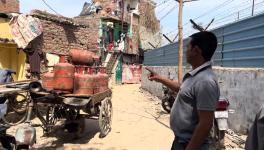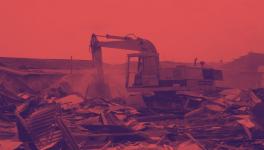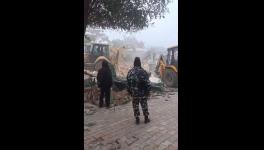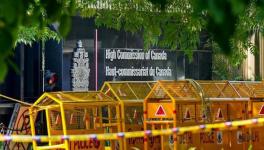Demolition Politics: First Tughlaqabad, Now Mehrauli – Uncertainty Grips Residents

Representational Image.
The Union government’s promise of ‘Jahan Jhuggi Wahan Makan’ scheme falls short yet again as a massive anti-encroachment drive in Mehrauli ahead of the 2023 G20 Summit leaves hundreds of people with an uncertain future. The demolition drive is set to continue till March 9, despite an order of the Delhi High Court to stop it and maintain status quo.
—–
As south Delhi’s Mehrauli Archeological Park gets a makeover ahead of the G-20 Summit in Delhi in September, a massive anti-encroachment drive by the Delhi Development Authority (DDA) took place in the Ladha Sarai village of Mehrauli on February 10. The demolition drive was carried out pursuant to hundreds of eviction orders slapped by the DDA last December, which ordered that encroachers remove themselves within ten days.
The Mehrauli Archaeological Park houses nearly 55 monuments under the protection of the Archaeological Survey of India (ASI), the DDA, and the Delhi government’s Department of Archaeology.
The DDA demolished several jhuggi jhopri (JJ) clusters and other multi-storey buildings situated on the border of Mehrauli Archaeological Park, in Ladha Sarai village, in the name of its so-called demarcation exercise to remove the encroachment. The exercise is alleged to have been pending for years. However, the bulldozers were met with resistance by the residents, who continued to protest against the demolition drive amid heavy police security and knocked on the doors of the Delhi High Court, requesting to stop the demolition.
What kind of interim relief has been granted to the residents by the Delhi High Court, and why?
The DDA continued its demolition drive on Saturday despite the order of the Delhi High Court’s single-judge bench of Justice Manmeet Preetam Singh Arora on Friday to put on hold the demolition and maintain the status quo at the Ghosiya slum colony in Gosiya Colony Sewa Samiti versus Delhi Development Authority.
The petition was filed by the inhabitants of the Ghosiya slum colony in Mehrauli, housing around 400 JJ clusters.
Advocate Anuprada Singh, for the petitioner, told the court that the colony appears at serial no. 18 of the Delhi Urban Shelter Improvement Board (DUSIB) list published on its website in 2018. DUSIB is respondent no. 2 in this case.
Singh also told the court that no eviction notices were served to the residents of the slum dwelling and that the entire demolition action is illegal.
She also stated that ‘Code no. 769’ has been assigned to this basti, located in Mehrauli, and the list records the existence of 400 jhuggis. This is, therefore, a notified JJ cluster and the jhuggis cannot be demolished in the matter sought to be done by the DDA, Singh submitted before the high court.
Further, Singh also told the court that DDA is a land-owning agency and is obliged to rehabilitate the residents of the slum colony prior to their eviction, under the Delhi Slum and JJ Rehabilitation and Relocation Policy, 2015 of the DUSIB. The policy designates DUSIB as the nodal agency to implement this policy.
The policy, which also refers to many Supreme Court and high court judgments, observing that the right to housing is a fundamental right, clearly states that DUSIB shall make all efforts to relocate the people of JJ clusters before a demolition is to be performed.
The counsel for DUSIB did not have instructions on the matter and requested an adjournment.
The order of the high court reads: “In light of the averment that Ghosiya Slum Colony is a Jhuggi cluster duly enlisted in the list published by DUSIB on its official website, which records 400 Jhuggis, as also the 2015 policy and the fact that the respondents do not have instructions in the matter, the respondents are directed to maintain status quo with respect to the 400 jhuggis verified by Respondent No. 2, until the next date of hearing.”
The DDA continued its demolition drive on Saturday despite the order of the Delhi High Court’s single-judge bench of Justice Manmeet Preetam Singh Arora on Friday.
The high court is set to next hear the matter on February 14. Although the DDA has claimed that no house in the slum cluster has been demolished, it does not assuage the residents’ fear and uncertainty.
Many other affected inhabitants of other colonies have also filed urgent petitions before the Delhi High Court.
Four separate petitions have been filed with regard to buildings located in Khasra No. 1151/3 min. in village Mehrauli, which is not mentioned in the December demolition order; yet, demolition action has been proposed in the area as well.
In each of the petitions, Justice Arora has given the same interim order, directing: “In view of the fact that Khasra No. 1151/3 min. finds no mention in the demolition order dated December 12, 2022, it is directed that status quo be maintained with respect to the subject property, until the next date of hearing.”
All these petitions will be heard on merits on February 16.
Why the Delhi government and the DDA are at loggerheads over the demolition drive
In a statement released on February 11, the DDA said that the demolition drive to clear “unauthorised encroachments” on government land that houses protected ASI monuments, among others, has been started by the DDA in coordination with Delhi Police at Ladha Sarai village falling in the Mehrauli Archaeological Park.
The statement further said, “All stakeholders, including the [Delhi government], have been on board in the run-up to this long pending, Court-mandated exercise.” It also said that the land of the Ladha Sarai village, involved in the December demolition order, belongs to the government/DDA.
“[T]he exercise is on, to reclaim encroached government land for its rightful use by all citizens as a park,” the statement noted.
During the February 10 demolition drive, the DDA reclaimed approximately 1,200 square metres of the land as a part of the Mehrauli Archeological Park. The encroachment area is said to be spread out across 20 acres.
The Delhi revenue department’s demarcation report is claimed to be the only source for these demolitions. The Delhi government has asked the DDA to stop the demolition drive until a fresh exercise is ordered.
In the statement, the DDA clarified that the demolition drive is a “demarcation exercise” which was carried out as per the directions of the Delhi High Court by the Delhi government’s revenue department, and in the presence of the representatives of the DDA and the Waqf Board.
While the DDA’s statement says that the Delhi government has approved the exercise, the Aam Aadmi Party (AAP)-led Delhi government claims otherwise. It has opposed the demolition and has demanded a fresh demarcation exercise.
According to a report by The Hindu, Delhi Revenue Minister Kailash Gahlot alleged that the DDA used the revenue department’s demarcation report as the basis for the demolition, even though the Delhi government has struck down the survey report after finding shortcomings in it.
As per the AAP, the residents of Mehrauli are victims of the continued political tussle between the Delhi government and the Bharatiya Janata Party (BJP) after the former won the Municipal Corporation of Delhi’s elections, for the first time in fifteen years, unseating the BJP.
It is also clear that the Delhi government is at the loggerheads with the BJP-led Union government-appointed Lieutenant Governor V.K. Saxena, who also happens to be the Chairman of DDA.
The Delhi BJP spokesperson Praveen Shankar Kapoor has countered the Delhi government’s allegations, and said, as per the report by The Hindu, “People of Delhi are shocked to see the callousness of the Arvind Kejriwal government of giving the DDA a wrong survey report because of which dozens of families have lost their homes and more are under the hammer.”
According to the same The Hindu report, a senior DDA official said that the land-owning agency has not been given any formal communication that the demarcation report was rejected.
The revenue department’s demarcation report is claimed to be the only source for these demolitions. Gahlot has asked the DDA to stop the demolition drive until a fresh exercise is ordered. Nevertheless, the damage has already been done as the DDA continues its demolition drive.
What is the history of litigation relating to alleged land encroachment in Mehrauli?
Further, the DDA’s statement terming the exercise as a “court-mandated” exercise is not fully accurate when Mehrauli has seen a whirlwind of litigation related to alleged land encroachment in the past, often with contradictory decisions, and none of them providing any clarity.
The Mehrauli Archaeological Park is one of the largest archaeological parks in the country. The site comprises over a hundred significant heritage structures, archaeological monuments and graveyards. While some of the alleged “encroachment area” is the DDA’s, the rest is said to be owned by the Waqf Board and the ASI.
Several legal battles over the removal of encroachments have been fought over the years to protect its heritage structure, the ownership of certain plots of land, and concerns of the existing inhabitants.
Interestingly, a division bench of the Delhi High Court gave a judgment, authored by Justice Arora, last December, denying the claims of the inhabitants of the JJ bastis in a Mehrauli graveyard. In Mohd Isreal and Ors. versus DDA & Ors, seven petitioners, who identified themselves as slum dwellers residing in the graveyard of Shahi Qabarastan in Khasra No. 163, Ward No. 1, Mehrauli, had received demolition order notices.
The Supreme Court had directed the ASI to file an affidavit indicating how many people were living in the protected area of the Tughlakabad Fort, on the basis of an aerial survey that had been conducted in 1993. Then in 2017, the Delhi High Court established a committee to oversee the task of conducting a survey of the structure. There is nothing on record to show that any such survey has been conducted yet.
The petitioners told the court that they had constructed jhuggis in the graveyard and had been residing there peacefully for the past thirty years. However, the court did not grant them any relief and ordered them to vacate their jhuggis by January 15.
The judgment stated that the high court cannot examine the petitioners’ rehabilitation claims under the 2015 Policy, and that the same must be examined by the competent authority (that is, the DUSIB).
In another case, in a petition filed to preserve historical monuments from encroachment, in The Indian National Trust for Art & Cultural Heritage (INTACH) versus DDA & Ors, the Delhi High Court had ordered in April 2015 that all adequate measures shall be taken to ensure the entire area covered by the Mehrauli Archaeological Park is secured and free from encroachments. In a subsequent order in May 2015, it was clarified that no authorised occupant was to be removed from the land, which includes Wakf property.
As per the court’s order of December 2015, it was noted that the demarcation exercise was completed by the Delhi government. But the petition remains pending and will now be heard in April.
Another petition filed by the Managing Committee of Delhi Waqf Board’s Masajids, Graveyards and Land/Properties at Ladha Sarai also remains pending. In all these petitions, the demarcation exercise remains contested.
Is this part of a pattern of similar demolitions in Delhi?
Similar demolitions are being witnessed across the city. Another anti-encroachment drive took place last month for the alleged illegal occupants residing inside and around the Tughlakabad Fort. On January 11, the ASI pasted over 1,000 notices on the walls of the houses and gave an ultimatum to the people to either vacate the space within fifteen days or face demolition. No rehabilitation measures were suggested.
The demolition will affect more than 20,000 people who have been living here for years. The Delhi Commission for the Protection of Child Rights (DCPCR) has taken suo motu cognisance of these notices and asked the ASI to provide its correspondence with other executive agencies regarding the enablement of measures for the rehabilitation of children. It has suggested that the ASI suspend the demolition drive till rehabilitation measures are taken.
In 2011, the Supreme Court in S.N. Bhardwaj versus ASI & Ors. had ordered that no further construction shall take place in the protected area of Tughlakabad Fort. It had directed the ASI to file an affidavit indicating how many people were living in the protected area of the Tughlakabad Fort, on the basis of an aerial survey that had been conducted in 1993. Then in 2017, the Delhi High Court established a committee to oversee the task of conducting a survey of the structure.
Despite there being a nodal agency under the 2015 rehabilitation policy, there is a complete lack of coordination amongst the different public authorities that are stakeholders in these matters. This ultimately impacts the residents, who are not aware of their rights. There is also no awareness amongst them on who to approach for their rehabilitation claims.
There is nothing on record to show that any such survey has been conducted yet.
Why is slum eviction a serious problem?
JJ clusters, mostly located on public land, are one of the seven types of unplanned settlements designated by the Delhi government. These clusters and colonies are constructed without permission, and the concerned authorities usually turn a blind eye. However, after some years, the residents become ‘encroachers’ and receive eviction notices because of the government’s urgent need to grab the land. In such cases, no proper procedure, which includes resettlement, is followed.
Something similar happened when Delhi hosted the Commonwealth Games in 2010. More than 250,000 people lost their homes as a direct result of the games since 2004, a study by the Housing and Land Rights Network claimed.
The study disclosed that these forced evictions were in breach of the United Nations Basic Principles and Guidelines on Development-based Evictions and Displacement. The Principles mandate that just compensation and alternative housing must be offered.
The problem at the core of the issue is that despite there being a nodal agency under the 2015 rehabilitation policy, there is a complete lack of coordination amongst the different public authorities that are stakeholders in these matters. This ultimately impacts the residents, who are not aware of their rights. There is also no awareness amongst them on who to approach for their rehabilitation claims. In the end, the residents, who are poor people, are left with nowhere to go.
Gursimran Kaur Bakshi is a staff writer at The Leaflet
Get the latest reports & analysis with people's perspective on Protests, movements & deep analytical videos, discussions of the current affairs in your Telegram app. Subscribe to NewsClick's Telegram channel & get Real-Time updates on stories, as they get published on our website.
























